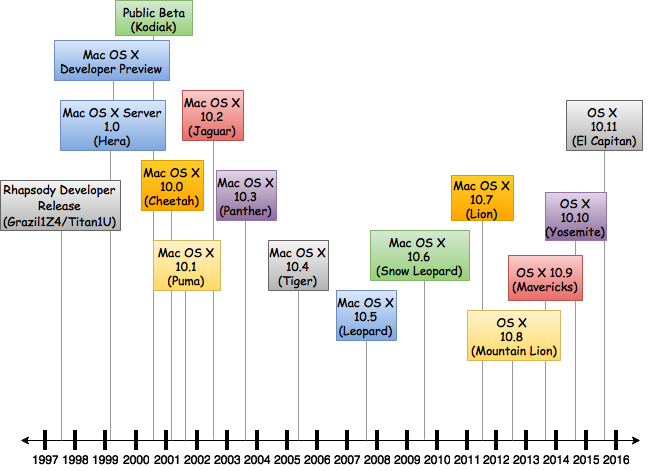

- List of all mac os names and year mac os x#
- List of all mac os names and year install#
- List of all mac os names and year update#
Apple pushed out future software updates via the Mac App Store, which was introduced in Mac OS X 10.6.6. Snow Leopard was the last OS available on disc. New security features and yet another new look rounded out the OS.

It was the last OS to support PowerPC architecture.Īpple's Time Machine backup software, Spaces, and Boot Camp came pre-installed in Leopard, along with support for 64-bit applications.
List of all mac os names and year install#
Mac OS X 10.5 Leopard (2007)Ī large update, Leopard, could work on PowerPC and Intel Macs, but it needed a G4 processor with a minimum clock rate of 867MHz and at least 512MB of RAM to install and function. As Apple started building Intel-based Macs, Tiger functioned on these new devices the way it did on existing PowerPC Macs. Tiger added Spotlight, Dashboard, Smart Folders, Automator, and VoiceOver though, and updated Safari, Quicktime, and Mail. Panther had not worked on the Power Macintosh and the PowerBook this meant even more Apple computers were losing OS support. Tiger could only operate on Macs with a built-in FireWire port.

It also added a brushed-metal look to the interface, influencing future design choices for a while. Panther added in Safari and FileVault, allowed faster user switching, and included a Finder update. Going forward, users would see the Apple logo when they turned on their Mac instead.
List of all mac os names and year update#
The "Happy Mac" face was retired in this update after 18 years. Jaguar had better performance than its predecessors and better compositing graphics, allowing iChat and Address Book to work on Macs. Upgrading from classic Mac OS versions cost users money at this time, but at least upgrading from Cheetah to Puma was free. Puma, released six months after Cheetah, added missing features from 10.0, like DVD playback.Ī few months after Puma came out, Apple announced Mac OS X would become the default OS for its computers. Still, as bugs were corrected, it became a solid base for the new Mac OS X line. Mac OS X 10.0 Cheetah (2001)ĭespite its name, Cheetah was a slow OS and didn't come with many applications.

The beta stopped working once Cheetah hit the market. Released in 2000, Kodiak was sold to users so Apple could get feedback on the new OS format. So, let's get started: Mac OS X Public Beta Kodiak (2000) It's easier to discuss each version's highlights one by one to understand this era of operating systems for the Mac. Mac OS 9 ended the era of "classic" Mac OS, passing features along to Mac OS X (X being the Roman numeral for 10), and the modern macOS. Mac OS 9 improved wireless networking support and introduced Remote Networking, on-the-fly file encryption, and an early version of multi-user support. It did add HFS+ and the ability to clone files in the background. Mac OS 8 wasn't very different from 7-it was named 8 to terminate third-party manufacturers' licenses to System 7 and stop the manufacturing of Mac clones. This update was called Mac OS 7.6, and the "Mac OS" naming trend would continue into Mac OS 8 and Mac OS 9 in 19. The naming system of Mac OS changed with an update to System 7. It also added new applications and changed the user interface quite a bit. It had virtual memory support, built-in cooperative multitasking, and added aliases. In late 1987, System Software 5 finally allowed Mac users to run more than one application at a time, which System Software 6 improved upon in 1988.īig changes came when System 7 arrived in 1991.


 0 kommentar(er)
0 kommentar(er)
